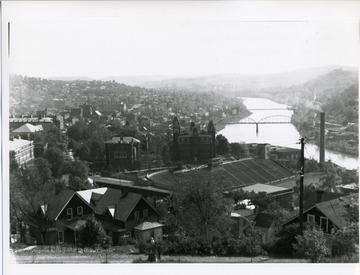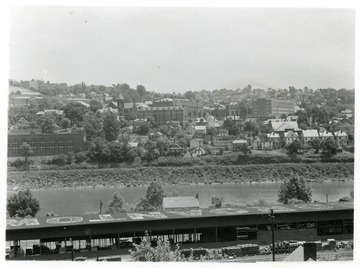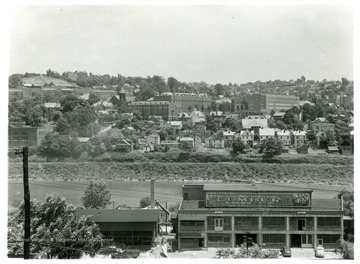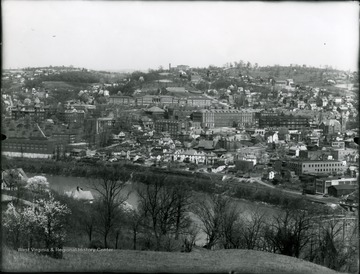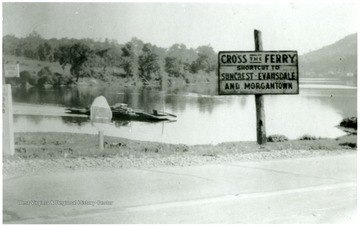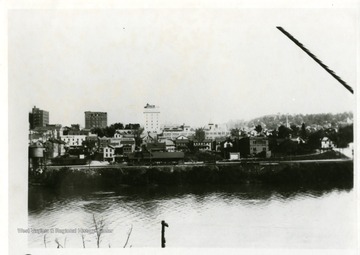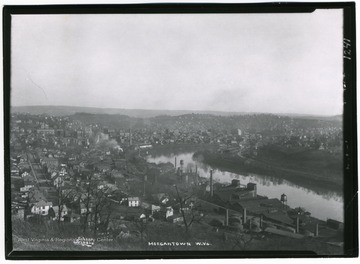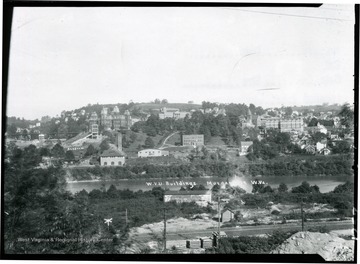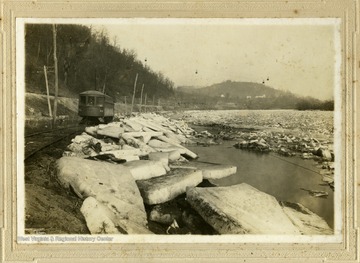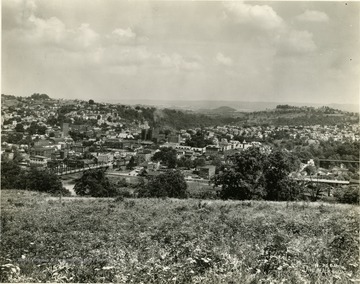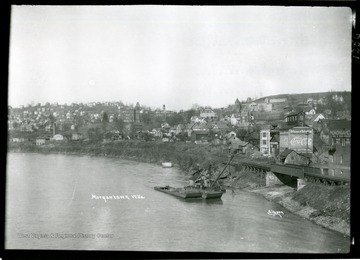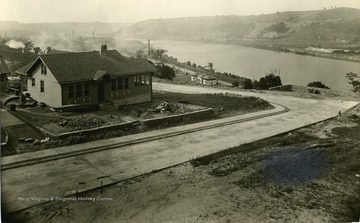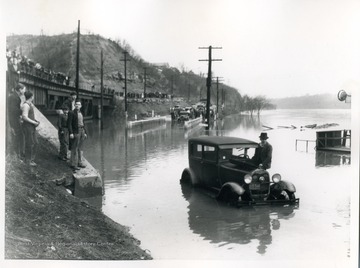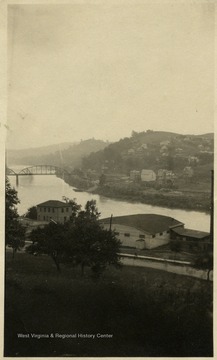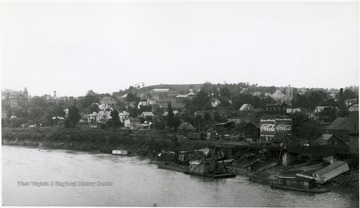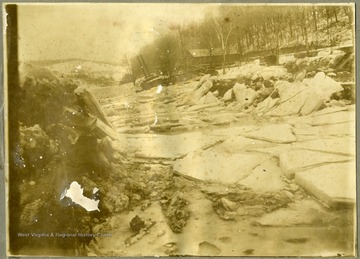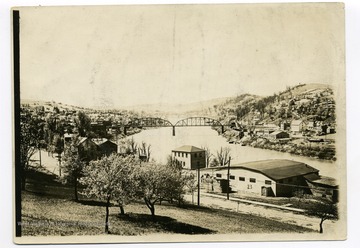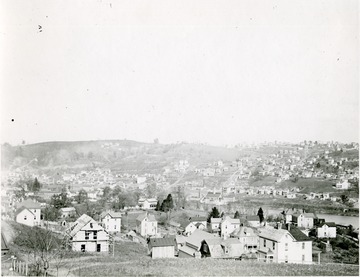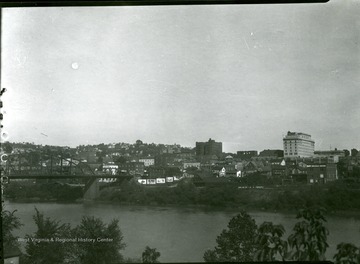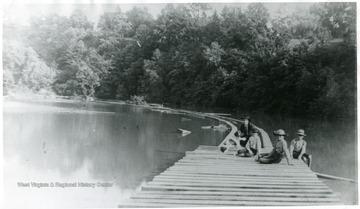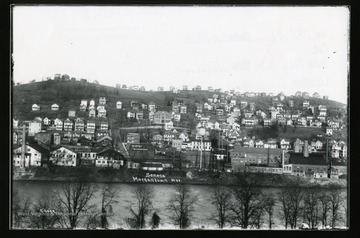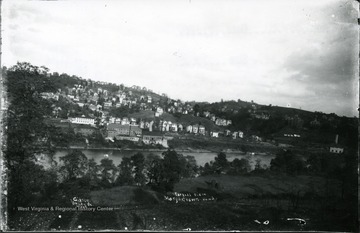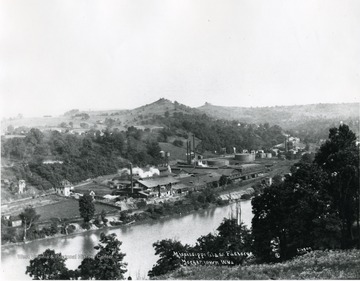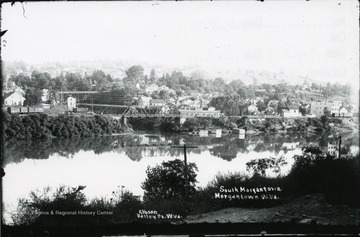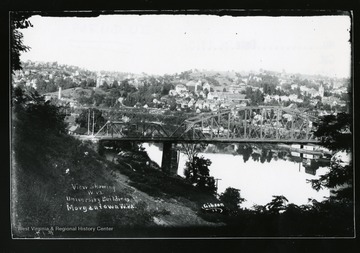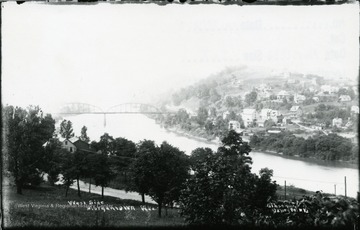Search Constraints
« Previous |
1 - 96 of 447
|
Next »
Search Results
IDNO:
010056
Title:
Floating Concert Hall on Monongahela River, Morgantown, W. Va.
Date:
undated
Description:
'Barging in for a summer concert is 'Point Counterpoint' -- concert hall of the American Wind Symphony Orchestra. During its 33 city tour of river communities, the floating concert hall is moved from port to port by towboat. One of the most unusual and resourcefull stages in the world, its amplifying system and modern lighting installations were designed with mobile practicality as well as theatrical showmanship in mind.'
IDNO:
029034
Title:
Testing the Pump on a Hinton Fire Department Truck
Date:
undated
Description:
A photograph of a Hinton, W. Va. fire truck next to the Monongahela River at Morgantown pumping water through a hose.
IDNO:
049971
Title:
View of the Westover Bridge, Morgantown, W. Va.
Date:
undated
Description:
View from the hill right above the Westover end of the River Bridge, back across the bridge
IDNO:
050028
Title:
View of Morgantown from Westover, W. Va.
Date:
undated
IDNO:
049973
Title:
Monongahela River and Seneca, Morgantown, W. Va.
Date:
undated
Description:
View from a boat on the river, looking toward Seneca
IDNO:
050031
Title:
View of Seneca from University Ave., Morgantown, W. Va.
Date:
undated
Description:
View from University Ave., above Beverly (street car tracks in foreground) looking down on Seneca
IDNO:
049966
Title:
South Morgantown, W. Va.
Date:
undated
IDNO:
049967
Title:
View of the River from the J. H. Stewart Window, Morgantown W. Va.
Date:
undated
IDNO:
049974
Title:
View of the Monongahela River and Bridge, Morgantown, W. Va.
Date:
undated
Description:
View from hill where Brooks, Armstrong, and Physics (WVU Buildings) are now, toward the River Bridge (after 1907).
IDNO:
050033
Title:
View from Westover across River, Morgantown, W. Va.
Date:
undated
IDNO:
050026
Title:
Morgantown view from Westover, W. Va.
Date:
undated
IDNO:
052957
Title:
Down the River from Morgantown, W. Va.
Date:
undated
Description:
A bird's eye view of the Seneca and Sunnyside neighborhoods of Morgantown, showing the Falling Run Bridge in the foreground.
IDNO:
020861
Title:
Aerial View of Coliseum, Natatorium, and Shell Building, West Virginia University
Date:
ca.1980-1990
Description:
Also shows WVU Baseball Diamond and Monongahela River.
IDNO:
010971
Title:
Suspension Bridge Across the Monongahela at Morgantown, W. Va.
Date:
ca.1888
Description:
'Morgantown from across the Monongahela River. Sometime in the late eighties. Note this is the suspension bridge the Confederates partly burned during the Jones-Imboden raid in the Civil War. Property of Jas. R. Moreland.'
IDNO:
020486
Title:
Aerial View of Downtown Campus, West Virginia University
Date:
ca. 1980-1988
Description:
'Notice both old and new Mountaineer fields are in this photograph.'
IDNO:
020484
Title:
Aerial View of Downtown Campus, West Virginia University
Date:
ca. 1965-1971
IDNO:
020475
Title:
Aerial View of Mountaineer Field and Surrounding Buildings, West Virginia University
Date:
ca. 1965-1971
IDNO:
020482
Title:
Aerial View of Downtown Campus, West Virginia University
Date:
ca. 1965-1971
IDNO:
018135
Title:
Mountaineer Field End Zone, and Scoreboard Viewed from the Press Box
Date:
ca. 1965-1971
Description:
Monongahela river in the background.
IDNO:
020452
Title:
Aerial View of Downtown Campus, West Virginia University
Date:
ca. 1965- 1971
IDNO:
020395
Title:
Aerial View of Downtown Campus, West Virginia University
Date:
ca. 1965- 1971
IDNO:
020450
Title:
Aerial View of Downtown Campus, West Virginia University
Date:
ca. 1965- 1971
IDNO:
020397
Title:
Aerial View of Downtown Campus, West Virginia University
Date:
ca. 1965- 1971
IDNO:
020455
Title:
Aerial View of Downtown Campus, West Virginia University
Date:
ca. 1965- 1971
IDNO:
020390
Title:
Aerial View of Downtown Campus, West Virginia University
Date:
ca. 1965- 1971
IDNO:
020388
Title:
Aerial View of Downtown Campus, West Virginia University
Date:
ca. 1965- 1971
IDNO:
019391
Title:
Stansbury Hall with River Bridge in the Background, West Virginia University
Date:
ca. 1965
IDNO:
011155
Title:
Aerial View of Downtown Campus, West Virginia University
Date:
ca. 1965
IDNO:
022646
Title:
Bird's Eye View of Morgantown, W. Va.
Date:
ca. 1965
Description:
Includes West Virginia University campus, and Mountaineer Field (on left).
IDNO:
022999
Title:
Night Scene of Downtown from Westover, Morgantown, W. Va.
Date:
ca. 1965
IDNO:
008238
Title:
Misspelled Sign on Star City Bridge, Morgantown, W. Va.
Date:
ca. 1963
Description:
Misspelled sign by the Star City Bridge should have read: Monongahela River Navigable elevation 828 feet. The word navigable is misspelled.
IDNO:
008237
Title:
Misspelled Sign on Star City Bridge, Morgantown, W. Va.
Date:
ca. 1963
Description:
Misspelled sign by the Star City Bridge should have read: Monongahela River Navigable elevation 828 feet. The word navigable is misspelled.
IDNO:
016817
Title:
Green Bag Cement Company Property, Monongalia County, W. Va.
Date:
ca. 1961
Description:
View of railroad track along river.
IDNO:
016340
Title:
Ice at the Locks on the Monongahela River, Monongalia County, W. Va.
Date:
ca. 1960-1970
IDNO:
016350
Title:
Lock and Dam on the Monongahela River, Morgantown, W. Va.
Date:
ca. 1960-1970
IDNO:
016365
Title:
Aerial View of Site of Fort Martin Power Plant, Monongalia County, W. Va.
Date:
ca. 1960-1970
Description:
"The rectangle in the center of the picture above marks the location of Fort Martin Power Station, the first unit of which is scheduled for completion in 1967. The unit will cost $57.5 million, will have a generating capability of 500,000 kilowatts and will burn about 1,350,000 tons of coal per year, all of which will come from mines in the immediate area. The plant will be about three-quarters of a mile upstream from the Pennsylvania state line."
IDNO:
011525
Title:
Dredging in the Monongahela River near Morgantown, W. Va.
Date:
ca. 1960-1970
Description:
'One of the last Stern Wheel Paddle Steamboats used' also pictured.
IDNO:
016939
Title:
Pulling a Car From the River, Monongalia County, W. Va.
Date:
ca. 1960- 1970
IDNO:
016937
Title:
Sunken Barge at Granville, Monongalia County, W. Va.
Date:
ca. 1960- 1970
IDNO:
016940
Title:
Construction of Opekiska Dam, Monongalia County, W. Va.
Date:
ca. 1960- 1970
IDNO:
016923
Title:
Jimtown, Monongalia County, W. Va.
Date:
ca. 1960- 1970
Description:
Distant view of Jimtown across the river.
IDNO:
016919
Title:
Monongahela River at Uffington, Monongalia County, W. Va.
Date:
ca. 1960- 1970
IDNO:
011110
Title:
Aerial View of Morgantown, W. Va.
Date:
ca. 1955
IDNO:
020399
Title:
Aerial View of Downtown Campus, West Virginia University
Date:
ca. 1954
IDNO:
020485
Title:
View of Downtown Campus from Westover, WVU
Date:
ca. 1954
IDNO:
011207
Title:
Rooftop View of Morgantown, W. Va.
Date:
ca. 1950
IDNO:
010945
Title:
Building the Bridge at Star City, Morgantown, W. Va.
Date:
ca. 1949
Description:
'East side of [Monongahela] river, Star City at left'.
IDNO:
012209
Title:
Main Campus of West Virginia University from Lorentz Avenue, Morgantown, W. Va.
Date:
ca. 1945
Description:
Stadium and Woodburn Hall are in the foreground and the River Bridge over the Monongahela River is in the background.
IDNO:
012015
Title:
Monongahela River and West Virginia University Campus from Lorentz Avenue, Morgantown, W. Va.
Date:
ca. 1945
Description:
View overlooking the Monongahela River and WVU builings and stadium.
IDNO:
020381
Title:
View of Downtown Campus from Westover, WVU
Date:
ca. 1943
IDNO:
020295
Title:
View of West Virginia University from Westover, Morgantown, W. Va.
Date:
ca. 1943
IDNO:
020386
Title:
View of Downtown Campus from Westover, WVU
Date:
ca. 1943
IDNO:
020384
Title:
View of Downtown Campus from Westover, WVU
Date:
ca. 1943
IDNO:
037590
Title:
View of General Woodworking Lumber Company from across the Monongahela River, Morgantown, W. Va.
Date:
ca. 1940-1950
IDNO:
011220
Title:
Bird's Eye View of West Virginia University and Morgantown, W. Va.
Date:
ca. 1938
Description:
A view of Morgantown from Westover. WVU campus on the left and the Monongahela River running along the bottom. The River bridge is visible in the lower right hand corner and White Hall was under construction(middle of photograph).
IDNO:
016921
Title:
Cross the Ferry Shortcut to Suncrest, Evansdale and Morgantown, W. Va.
Date:
ca. 1932
Description:
View of a sign by the Monongahela River that reads 'Cross the Ferry Shortcut to Suncrest, Evansdale and Morgantown.'
IDNO:
011772
Title:
River Bridge and Morgantown, W. Va.
Date:
ca. 1930
IDNO:
011949
Title:
Looking Southwest from Greenmont toward Morgantown, W. Va.
Date:
ca. 1930
IDNO:
012174
Title:
View of Morgantown, W. Va. from the Westover Side of the Monongahela River
Date:
ca. 1930
IDNO:
011951
Title:
View of Morgantown, W. Va. from Hopecrest Hill
Date:
ca. 1930
IDNO:
025519
Title:
Monongahela River Drained During a Drought, Morgantown, W.Va.
Date:
ca. 1930
IDNO:
019284
Title:
Mountaineer Field Viewed from Westover, West Virginia University
Date:
ca. 1927
IDNO:
011052
Title:
Monongahela River, Morgantown, W. Va.
Date:
ca. 1926
Description:
'Looking south west to Lock No. 10 up the Monongahela River from bridge.'
IDNO:
010951
Title:
Looking North West Across the Monongahela River, Morgantown, W. Va.
Date:
ca. 1926
Description:
Looking west to the M. R. Depot-West Side
IDNO:
010908
Title:
View of Morgantown from the River Bridge, Morgantown, W. Va,
Date:
ca. 1926
Description:
'Looking South West from Monongalia River Bridge to Baltimore and Ohio Depot and Hotel Morgan.'
IDNO:
010922
Title:
Monongahela River Looking North East to Sunnyside, Morgantown, W. Va.
Date:
ca. 1926
Description:
'Looking north east to Sunny Side stadium and University Buildings from Monongahela River Bridge.'
IDNO:
011051
Title:
Monongahela River and Morgantown, W. Va.
Date:
ca. 1926
Description:
'Looking east from West Side of Monongahela River (Coal Tipple) showing Baltimore and Ohio Depot and Hotel Morgan.'
IDNO:
012091
Title:
Seneca Addition and Morgantown, W. Va.
Date:
ca. 1925
Description:
'A view of Senecca Addition and Morgantown, West Virginia - east side brick yard in lower right.'
IDNO:
020410
Title:
View of Downtown Campus from Westover, WVU
Date:
ca. 1924
Description:
'Stadium under construction.'
IDNO:
010994
Title:
Bunkard Valley Railroad Car, Morgantown, W. Va.
Date:
ca. 1920
Description:
'Car number 52. Running West between Granville and Jimtown (Randell). Beside Monongahela River. The buckets suspended above the river were used to carry coal from a mine on the West-side to the Baltimore and Ohio Rail Road shipping point on the East-side.
IDNO:
011177
Title:
Morgantown, W. Va.
Date:
ca. 1920
Description:
View of downtown Morgantown from Westover hillside.
IDNO:
012017
Title:
Barges at the Wharf Area, Morgantown, W. Va.
Date:
ca. 1920
Description:
West Virginia University is in the background.
IDNO:
010949
Title:
House under Construction on a Hill Above the Monongahela River, Morgantown, W. Va.
Date:
ca. 1920
Description:
Newly constructed residence located in Morgantown, West Virginia. On the far right of the picture is the Monongahela River.
IDNO:
012110
Title:
Flood Waters of the Monongahela River, Morgantown, W. Va.
Date:
ca. 1920
Description:
Man with his automobile in flood water along the Monongahela River on US 19 and West Virginia State Road 7, 100 near Morgantown, West Virginia.
IDNO:
034416
Title:
WVU Campus and Westover Along Monongahela River, Monongalia County, W. Va.
Date:
ca. 1920
Description:
The steel bridge to Westover is in background. The West Virginia University campus in the foreground, including the old fieldhouse called the "Ark", which is the white building with a curved roof.
IDNO:
010950
Title:
View of the Monongahela River with West Virginia University and Observatory Hill, Morgantown, W. Va.
Date:
ca. 1918
IDNO:
034381
Title:
Monongahela River Frozen Over in Monongalia County, W. Va.
Date:
ca. 1918
IDNO:
025510
Title:
Ice Flows on the Monongahela River Damages River Boats, Morgantown, W.Va.
Date:
ca. 1917-1918
Description:
'Many boats docked along the Monongahela were crushed by heavy ice flows during the Winter of 1917 - 1918. This view shows the conditions that existed near the Walnut Street Wharf.'
IDNO:
019985
Title:
Basketball Hall, West Virginia University
Date:
ca. 1916
Description:
View of Basketball Hall, 'The Ark', West Virginia University, completed on November 4, 1916 and other downtown campus buildings and the Monongahela River in the background. Steel bridge over the Monongahela river in the background.
IDNO:
011964
Title:
Wharf, Morgantown, W. Va.
Date:
ca. 1915
IDNO:
011102
Title:
Bird's Eye View of North Morgantown, W. Va.
Date:
ca. 1915
Description:
From Westover
IDNO:
011956
Title:
Morgantown, W. Va.
Date:
ca. 1915
Description:
A view of Morgantown taken from western side of the Monongahela river looking northeast.
IDNO:
012207
Title:
View of West Virginia University and Seneca, Morgantown, W. Va.
Date:
ca. 1912
Description:
View across Monongahela River of WVU buildings and Seneca section of Morgantown W. Va. Woodburn Hall is at the far right.
IDNO:
010991
Title:
Boys on the Monongahela River, Morgantown, W. Va.
Date:
ca. 1910
IDNO:
010929
Title:
Seneca Neighborhood, Morgantown, W. Va.
Date:
ca. 1910
Description:
A view of the houses in the Seneca section of Morgantown, West Virginia.
IDNO:
011948
Title:
View of Morgantown, W. Va.
Date:
ca. 1910
Description:
A partial view of Morgantown from Westover.
IDNO:
011715
Title:
Monongahela and Ohio Packet Company Boat, Morgantown, W. Va.
Date:
ca. 1910
IDNO:
016835
Title:
Brewer Hill, Star City, W. Va.
Date:
ca. 1910
IDNO:
010997
Title:
Morgantown From the West Side of the Monongahela River, Morgantown, W. Va.
Date:
ca. 1910
IDNO:
011773
Title:
River Bridge and Morgantown, W. Va.
Date:
ca. 1910
Description:
A picture postcard of a view of Morgantown, West Virginia from Westover.
IDNO:
011908
Title:
Mississippi Glass Factory, Morgantown, W. Va.
Date:
ca. 1910
Description:
A view of the Mississippi Glass factory in South Morgantown.
IDNO:
009599
Title:
Canoeing on the Monongahela River, Morgantown, W. Va.
Date:
ca. 1910
IDNO:
012129
Title:
South Morgantown, W. Va.
Date:
ca. 1910
Description:
South Morgantown from the West.
IDNO:
010917
Title:
River Bridge and Morgantown, W. Va.
Date:
ca. 1910
Description:
A view from the west of Morgantown, West Virginia.
IDNO:
011769
Title:
River Bridge and Morgantown, W. Va.
Date:
ca. 1910
Description:
View from Westover. The Westover Bridge and several West Virginia University buildings are shown in this photograph.
IDNO:
012121
Title:
Westover, Morgantown, W. Va.
Date:
ca. 1910
Description:
Distant view of Westover on the West Side of the Monongahela River.
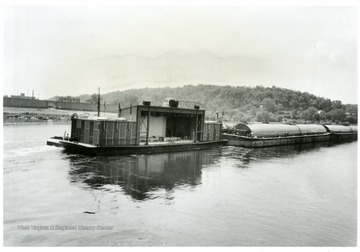
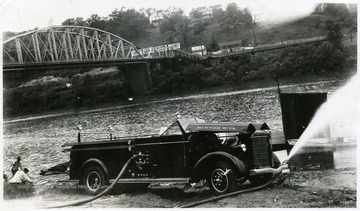
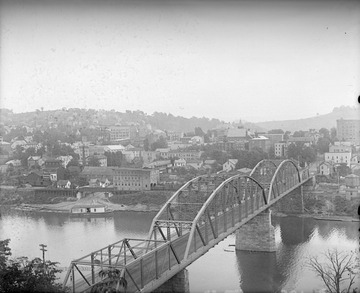

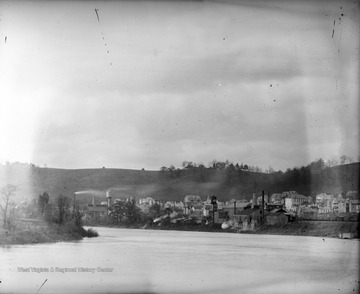
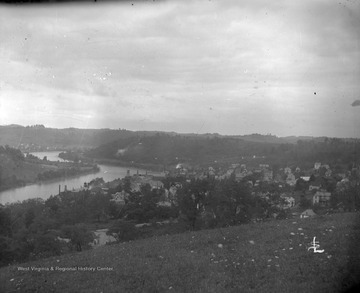


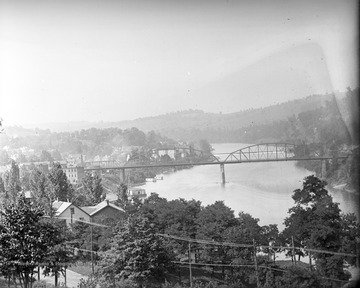


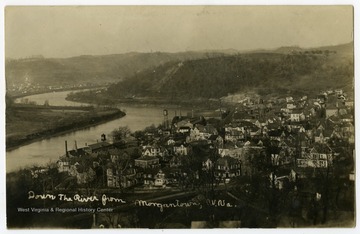


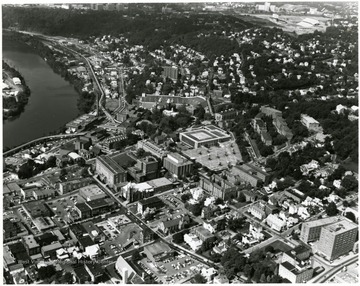


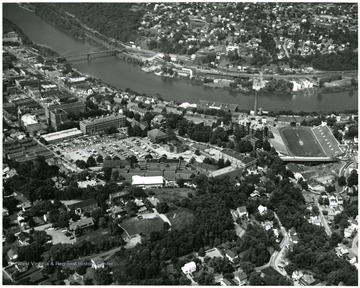
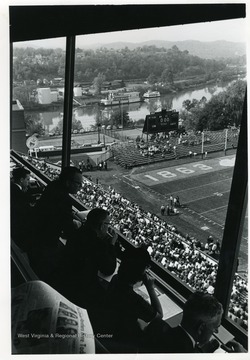









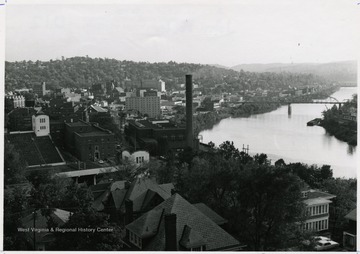

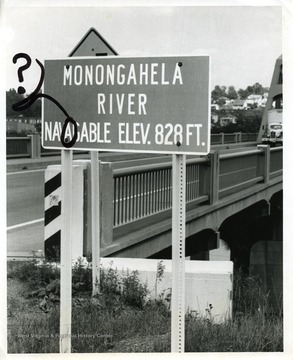
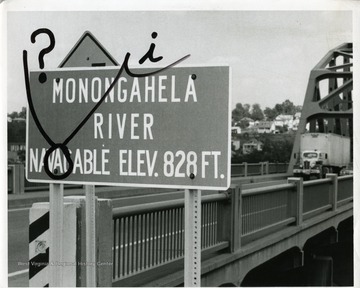
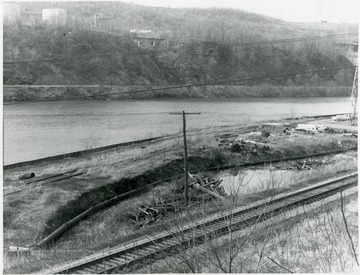

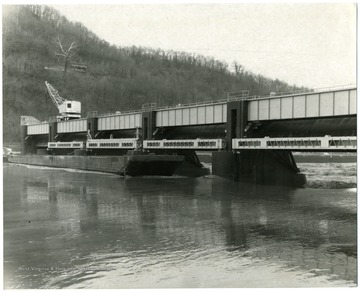
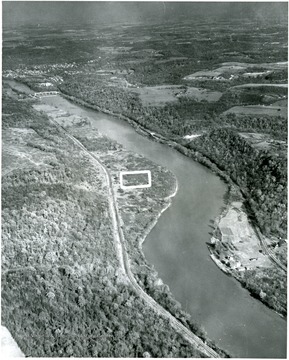
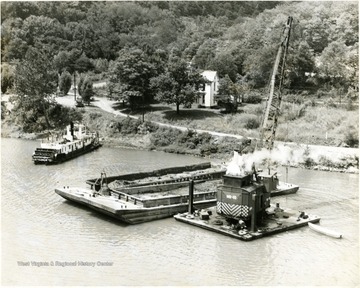
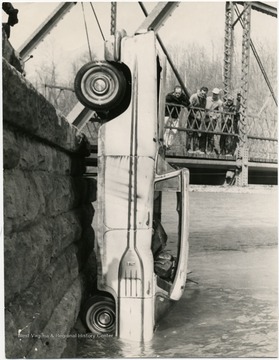
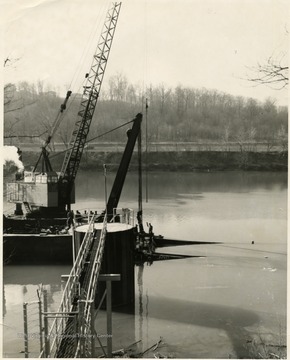

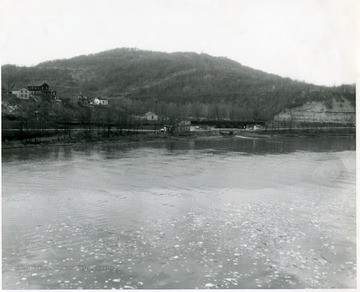





![Building the Bridge at Star City, Morgantown, W. Va. 'East side of [Monongahela] river, Star City at left'.](/thumb/010945.jpg)

